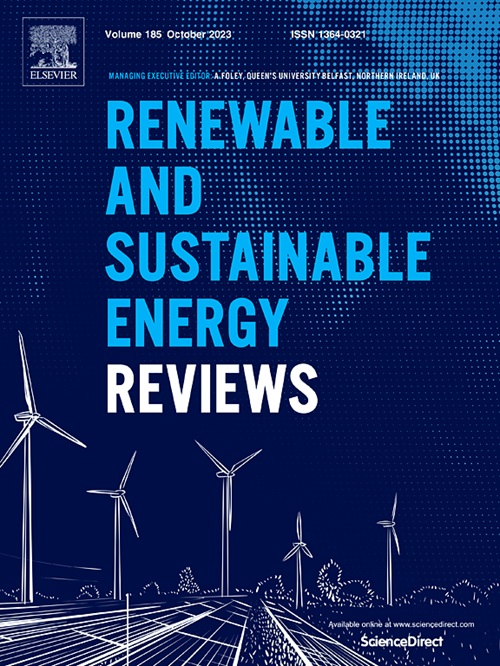季节性、电网规模调度地质蓄热研究进展
IF 16.3
1区 工程技术
Q1 ENERGY & FUELS
引用次数: 0
摘要
能源储存对于美国电网的脱碳至关重要,尤其是随着太阳能和风能等可变可再生能源的日益普及。地质热能储存(GeoTES)已成为一种有前途的长时间电网规模解决方案,通过灵活的操作和有价值的电网服务提供稳定性和安全性。GeoTES利用地下储层储存热能,用于发电和直接加热和冷却。这种方法大大提高了低温水库的使用,否则低温水库不适合地热发电厂。它还与枯竭的油气储层、聚光太阳能、非灵活的可再生能源(光伏和风能)以及与地热相关的电力循环相匹配。考虑到GeoTES有利的边际成本随着存储时间的增加而增加,它在季节性电网规模调度方面变得特别有竞争力,因为很少有技术是可行的。本文全面回顾了GeoTES系统及其发展的研究基础。本分析首先定义和分类热能储存技术的独特特征,将GeoTES与其他技术区分开来。然后探讨了指导GeoTES开发的各种组件、配置、地下特征和建模工作。最后,讨论了GeoTES研究、开发和部署方面的挑战,以及缓解战略和相关技术的经验教训。除了经济效益外,GeoTES系统还支持电网恢复能力和工业过程脱碳。GeoTES的可扩展性、广泛的分布、季节性存储潜力和灵活的调度能力使其成为扩大可再生能源部署和应对气候变化的宝贵工具。本文章由计算机程序翻译,如有差异,请以英文原文为准。

A review of Geological Thermal Energy Storage for seasonal, grid-scale dispatching
Energy storage is essential for the decarbonization of the U.S. energy grid, especially with the increasing deployment of variable renewable energy sources like solar and wind. Geological thermal energy storage (GeoTES) has emerged as a promising long duration, grid scale solution, providing stability and security through flexible operations and valuable grid services. GeoTES utilizes subsurface reservoirs to store thermal energy for power generation and direct-use heating and cooling. This approach significantly enhances the use of low-temperature reservoirs, which would otherwise be unsuitable for geothermal power plants. It also aligns well with depleted oil and gas reservoirs, concentrating solar power, non-flexible renewables (photovoltaic and wind), and geothermal-related power cycles. Given the favorable marginal costs of GeoTES as storage duration increases, it becomes particularly competitive for seasonal, grid-scale dispatch, where few technologies are viable.
This paper provides a comprehensive review of GeoTES systems and the research underpinning itsr development. This analysis begins by defining and categorizing the unique characteristics of thermal energy storage techniques, setting GeoTES apart from other technologies. The various components, configurations, subsurface characteristics, and modeling efforts that guide GeoTES development are then explored. Finally, challenges in GeoTES research, development, and deployment are discussed, along with mitigation strategies and lessons from related technologies.
Beyond their economic benefits, GeoTES systems support grid resilience and decarbonize industrial processes. Their scalability, broad distribution, seasonal storage potential, and flexible dispatch capacity make GeoTES a valuable tool for expanding renewable energy deployment and addressing climate change.
求助全文
通过发布文献求助,成功后即可免费获取论文全文。
去求助
来源期刊

Renewable and Sustainable Energy Reviews
工程技术-能源与燃料
CiteScore
31.20
自引率
5.70%
发文量
1055
审稿时长
62 days
期刊介绍:
The mission of Renewable and Sustainable Energy Reviews is to disseminate the most compelling and pertinent critical insights in renewable and sustainable energy, fostering collaboration among the research community, private sector, and policy and decision makers. The journal aims to exchange challenges, solutions, innovative concepts, and technologies, contributing to sustainable development, the transition to a low-carbon future, and the attainment of emissions targets outlined by the United Nations Framework Convention on Climate Change.
Renewable and Sustainable Energy Reviews publishes a diverse range of content, including review papers, original research, case studies, and analyses of new technologies, all featuring a substantial review component such as critique, comparison, or analysis. Introducing a distinctive paper type, Expert Insights, the journal presents commissioned mini-reviews authored by field leaders, addressing topics of significant interest. Case studies undergo consideration only if they showcase the work's applicability to other regions or contribute valuable insights to the broader field of renewable and sustainable energy. Notably, a bibliographic or literature review lacking critical analysis is deemed unsuitable for publication.
 求助内容:
求助内容: 应助结果提醒方式:
应助结果提醒方式:


